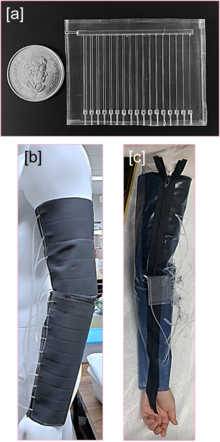Background
The air microfluidics-enabled active compression apparel belongs to the compression therapy market. The global compression therapy market size was valued at USD 3.1 billion in 2019 and is expected to reach USD 4.2 billion by 2025 at a compound annual growth rate (CAGR) of 4.8%. Compression therapy is the mainstay for treatment and management of chronic venous insufficiency (CVI), venous leg ulcers, chronic venous disease (CVD), deep vein thrombosis (DVT), lymphedema, dependent edema, varicose veins, venous thromboembolism (VTE), and gravitational eczema. This therapy is also preferred by sportspersons and athletes for treating musculoskeletal and spinal injuries and is routinely applied for the management of post orthopedic surgeries to alleviate pain, reduce swelling, and enable rapid functional recovery.
This market is driven by the significant growth in the aging and target patient populations, incidence of sports injuries and accidents, and clinical evidence favouring the adoption of compression therapy in the treatment and management of target diseases.
Description of the invention
Waterloo’s Air Microfluidics Enabled Active Compression Apparel provide a novel and disruptive microfluidic chip design which offers state-of-the-art sequential actuation capability with a miniaturized and low-cost control box. The wearable control box makes the apparel/sleeve lightweight and portable with much lower cost, noise, and battery consumption than its competitive counterparts. Waterloo’s current prototype demonstration is an effective, affordable, and wearable active edema/lymphedema sleeve.
Current competitive technologies rely on solenoid valves (as many as 17) which are costly, heavy, noisy, and power hungry. This ultimately results in trade-offs between performance, cost, and portability for end-users.
Waterloo’s Air Microfluidic Enabled Active Compression Apparel addresses all of these issues by offering state-of-the-art performance, while being cost effective, easy to use (donning and doffing), portable and comfortable to wear.
Advantages
- Novel and disruptive microfluidic chip design which offers state-of-the-art sequential actuation capability with a miniaturized and low-cost control box.
- Affordable, portable and wearable active edema sleeve/apparel.
- Much lower noise and battery consumption than competitive counterparts.
- Soft air bladder design that contours to the body while retaining a sleek low-profile aesthetics even when fully inflated.
Potential applications
- Treatment and management of lymphedema, dependent edema, CVI, venous leg ulcers, CVD, DVT, varicose veins, VTE, and gravitational eczema.
- Treatment of musculoskeletal and spinal injuries (e.g. sportspersons and athletes).

Figure 1. (a) Air Microfluidic Chip, (b) pull-on active compression sleeve, (c) zippered active compression sleeve.
Reference
10185
Patent status
PCT patent filed
Stage of development
Prototype developed and currently being validated
Contact
Scott Inwood
Director of Commercialization
Waterloo Commercialization Office
519-888-4567, ext. 33728
sinwood@uwaterloo.ca
uwaterloo.ca/research